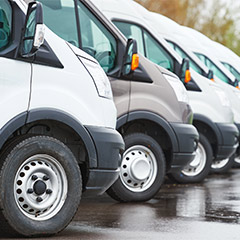Take Advantage of Expanded Tax Breaks for Business Vehicles
May 14, 2018 | Business Plans, Financial Planning, IRS Regulation, Tax Planning, Tax Preparation
 The first-year depreciation deductions for vehicles used more than 50% for business purposes has been expanded by the Tax Cuts and Jobs Act (TCJA). Here’s what Maine small business owners need to know to take advantage.
The first-year depreciation deductions for vehicles used more than 50% for business purposes has been expanded by the Tax Cuts and Jobs Act (TCJA). Here’s what Maine small business owners need to know to take advantage.
Depreciation Allowances for Passenger Vehicles
The TCJA dramatically and permanently increases the so-called “luxury auto” depreciation allowances for new and used passenger vehicles (including trucks, vans and electric automobiles) that are acquired and placed in service in 2018 and used more than 50% for business purposes.
The maximum allowances for passenger vehicles placed in service in 2018 are:
- $10,000 for the first year (or $18,000 if first-year bonus deprecation is claimed),
- $16,000 for the second year,
- $9,600 for the third year, and
- $5,760 for the fourth year and beyond until the vehicle is fully depreciated.
These allowances are cut back proportionately if the vehicle is used less than 100% for business. For 2019 and beyond, the allowances will be indexed for inflation.
First-Year Bonus Depreciation for Passenger Vehicles
If first-year bonus depreciation is claimed for a new or used passenger vehicle that’s acquired and placed in service between September 28, 2017, and December 31, 2026, the TCJA increases the maximum first-year luxury auto depreciation allowance by $8,000. So, for 2018, you can claim a total deduction of up to $18,000 for each qualifying vehicle that’s placed in service. Allowances for later years are unaffected by claiming first-year bonus depreciation.
However, there’s an important requirement: For a used vehicle to be eligible for first-year bonus deprecation, it must be new to the taxpayer (you or your business entity).
The $8,000 bump for first-year bonus depreciation is scheduled to disappear after 2026, unless Congress takes further action.
Prior-Law Allowances for Passenger Vehicles
Under prior law, used vehicles were ineligible for first-year bonus depreciation. In addition, the depreciation allowances for passenger vehicles were much skimpier in the past, so these expanded deductions represent a major improvement over the prior-law deductions.
For 2017, the prior-law allowances for passenger vehicles were:
- $3,160 for the first year (or $11,160 for a new car with additional first-year bonus depreciation),
- $5,100 for the second year,
- $3,050 for the third year, and
- $1,875 for the fourth year and beyond until the vehicle is fully depreciated.
Under prior law, slightly higher limits applied to light trucks and light vans for 2017.
Good News for Heavy SUVs, Pickups and Vans
Interestingly, the TCJA allows unlimited 100% first-year bonus depreciation for qualifying new and used assets that are acquired and placed in service between September 28, 2017, and December 31, 2022. However, as explained earlier, for a used asset to be eligible for 100% first-year bonus deprecation, it must be new to the taxpayer (you or your business entity).
Under prior law, the first-year bonus depreciation rate for 2017 was only 50%, and bonus depreciation wasn’t allowed for used assets.
Heavy SUVs, pickups and vans qualify for 100% first-year bonus depreciation because they are treated for tax purposes as transportation equipment. This can provide a huge tax break for buying new and used heavy vehicles that will be used over 50% in your Maine business.
However, if a heavy vehicle is used 50% or less for nonbusiness purposes, you must depreciate the business-use percentage of the vehicle’s cost over a six-year period.
Definition of a “Heavy Vehicle”
100% first-year bonus depreciation is only available when an SUV, pickup or van has a manufacturer’s gross vehicle weight rating (GVWR) above 6,000 pounds. Examples of suitably heavy vehicles include the Audi Q7, Buick Enclave, Chevy Tahoe, Ford Explorer, Jeep Grand Cherokee, Toyota Sequoia and lots of full-size pickups.
The GVWR of a vehicle can typically be verified by looking at the manufacturer’s label on the inside edge of the driver’s side door where the door hinges meet the frame.
Case in Point
To illustrate the potential savings from the new 100% first-year bonus depreciation break, suppose you buy a new $65,000 heavy SUV and use it 100% in your business in 2018. You can deduct the entire $65,000 in 2018.
What if you use the vehicle only 60% for business? Then your first-year deduction would be $39,000 (60% x $65,000).
Now, if you purchase a used heavy van for $45,000 in 2018. You can still deduct the entire cost in 2018, thanks to the 100% first-year bonus depreciation break. If you use the vehicle 75% for business, your first-year deduction is reduced to $33,750 (75% x $45,000).
Buy, Use, Save
Although the TCJA provided many complex changes to the tax law, the provisions that expand the first-year depreciation deductions for business vehicles are as easy as 1-2-3: 1) buy a vehicle, 2) use it for business, and 3) save on taxes.
Reach out to Filler & Associates or your tax advisor if you have questions about depreciation deductions on vehicles or want more information about other issues related to the new law.
